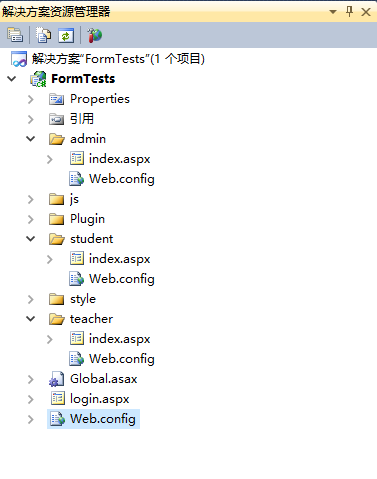Maison >développement back-end >Tutoriel C#.Net >Authentification par formulaires ASP.NET
Authentification par formulaires ASP.NET
- 高洛峰original
- 2017-02-10 17:09:061383parcourir
Dans le programme asp.net, les utilisateurs peuvent accéder aux pages et fonctions correspondantes en fonction de leurs rôles. Cet article présentera cela, qui a une très bonne valeur de référence. Suivons l'éditeur pour jeter un œil au développement du programme
asp.net. Les utilisateurs accèdent aux pages et fonctions correspondantes en fonction de leurs rôles.
La structure du projet est la suivante :

Code Web.config du répertoire racine :
<?xml version="1.0" encoding="utf-8"?>
<!--
有关如何配置 ASP.NET 应用程序的详细消息,请访问
http://www.php.cn/
-->
<configuration>
<system.web>
<compilation debug="true" targetFramework="4.0" />
<authentication mode="Forms">
<forms loginUrl="login.aspx"></forms>
</authentication>
<!--<authorization>
<allow users="*"></allow>
</authorization>-->
</system.web>
</configuration>Code Web.config dans le dossier admin :
<?xml version="1.0"?> <configuration> <system.web> <authorization> <allow roles="admin" /> <deny users="*"/> </authorization> </system.web> </configuration>
Code Web.config dans le dossier professeur :
<?xml version="1.0"?> <configuration> <system.web> <authorization> <allow roles="teacher" /> <deny users="*"/> </authorization> </system.web> </configuration>
Code Web.config dans le dossier étudiant :
<?xml version="1.0"?> <configuration> <system.web> <authorization> <allow roles="student" /> <deny users="*"/> </authorization> </system.web> </configuration>
Définissez le cookie après une connexion réussie dans Login.aspx, définissez le code du cookie :
protected void SetLoginCookie(string username, string roles)
{
System.Web.Security.FormsAuthentication.SetAuthCookie(username, false);
System.Web.Security.FormsAuthenticationTicket ticket = new FormsAuthenticationTicket(1, username, DateTime.Now, DateTime.Now.AddDays(1), false, roles, "/");
string hashTicket = FormsAuthentication.Encrypt(ticket);
HttpCookie userCookie = new HttpCookie(FormsAuthentication.FormsCookieName, hashTicket);
HttpContext.Current.Response.SetCookie(userCookie);
}Authentification dans Global.asax :
protected void Application_AuthenticateRequest(object sender, EventArgs e)
{
HttpApplication app = (HttpApplication)sender;
HttpContext ctx = app.Context; //获取本次Http请求的HttpContext对象
if (ctx.User != null)
{
if (ctx.Request.IsAuthenticated == true) //验证过的一般用户才能进行角色验证
{
System.Web.Security.FormsIdentity fi = (System.Web.Security.FormsIdentity)ctx.User.Identity;
System.Web.Security.FormsAuthenticationTicket ticket = fi.Ticket; //取得身份验证票
string userData = ticket.UserData;//从UserData中恢复role信息
string[] roles = userData.Split(','); //将角色数据转成字符串数组,得到相关的角色信息
ctx.User = new System.Security.Principal.GenericPrincipal(fi, roles); //这样当前用户就拥有角色信息了
}
}
}Pour plus d'articles liés à l'authentification d'identité ASP.NET Forms, veuillez faire attention au PHP Site chinois !

